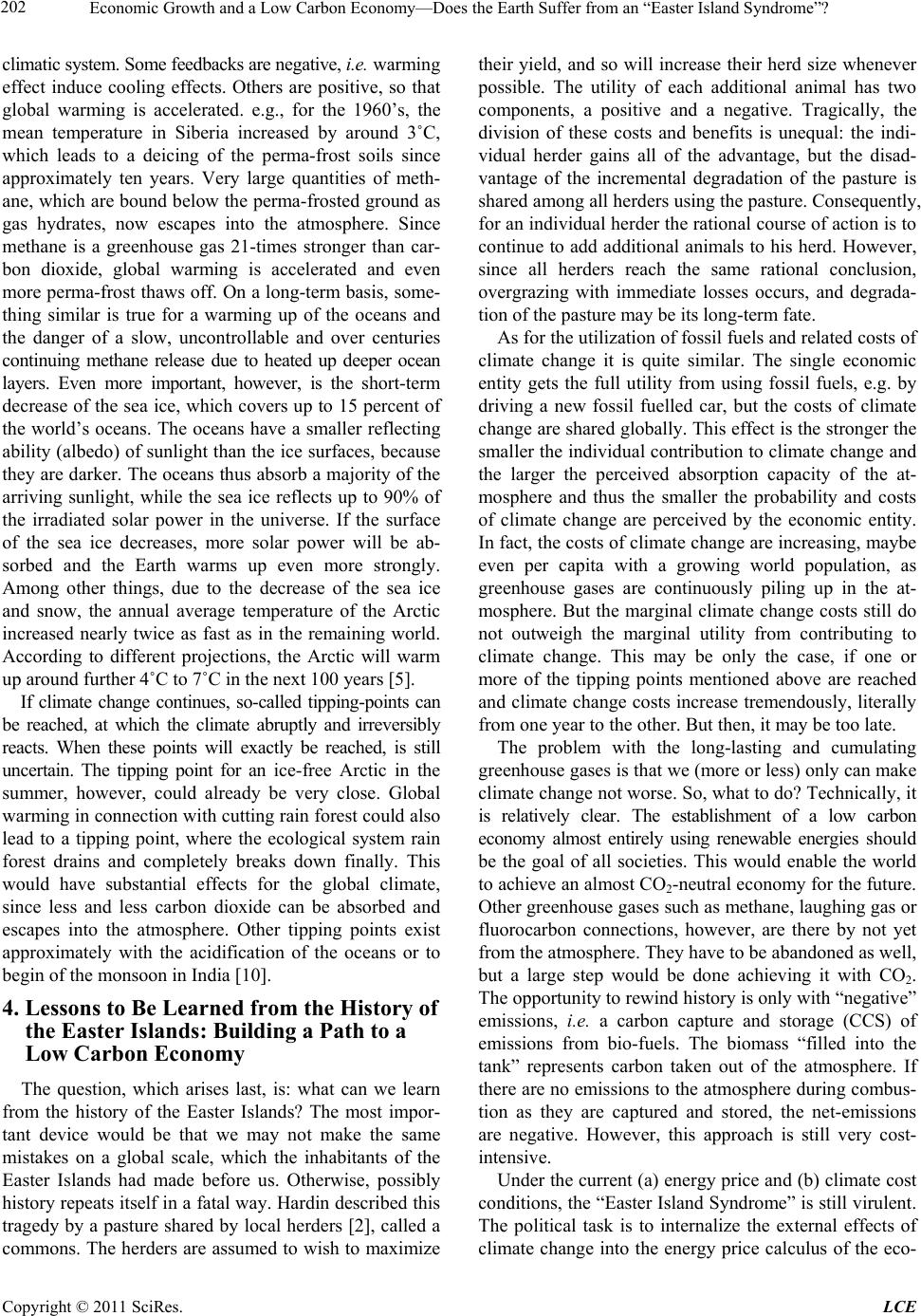
Economic Growth and a Low Carbon Economy—Does the Earth Suffer from an “Easter Island Syndrome”?
202
climatic system. Some feedbacks are negative, i.e. warming
effect induce cooling effects. Others are positive, so that
global warming is accelerated. e.g., for the 1960’s, the
mean temperature in Siberia increased by around 3˚C,
which leads to a deicing of the perma-frost soils since
approximately ten years. Very large quantities of meth-
ane, which are bound below the perma-frosted ground as
gas hydrates, now escapes into the atmosphere. Since
methane is a greenhouse gas 21-times stronger than car-
bon dioxide, global warming is accelerated and even
more perma-frost thaws off. On a long-term basis, some-
thing similar is true for a warming up of the oceans and
the danger of a slow, uncontrollable and over centuries
continuing methane release due to heated up deeper ocean
layers. Even more important, however, is the short-term
decrease of the sea ice, which covers up to 15 percent of
the world’s oceans. The oceans have a smaller reflecting
ability (albedo) of sunlight than the ice surfaces, because
they ar e darker. The oceans thu s absorb a major ity of the
arriving sunlight, while the sea ice reflects up to 90% of
the irradiated solar power in the universe. If the surface
of the sea ice decreases, more solar power will be ab-
sorbed and the Earth warms up even more strongly.
Among other things, due to the decrease of the sea ice
and snow, the annual average temperature of the Arctic
increased nearly twice as fast as in the remaining world.
According to different projections, the Arctic will warm
up around further 4˚C to 7˚C in the next 100 years [5].
If climate change continues, so-called tipping-points can
be reached, at which the climate abruptly and irreversibly
reacts. When these points will exactly be reached, is still
uncertain. The tipping point for an ice-free Arctic in the
summer, however, could already be very close. Global
warming in connection with cutting rain forest could also
lead to a tipping point, where the ecological system rain
forest drains and completely breaks down finally. This
would have substantial effects for the global climate,
since less and less carbon dioxide can be absorbed and
escapes into the atmosphere. Other tipping points exist
approximately with the acidification of the oceans or to
begin of the monsoon in India [10].
4. Lessons to Be Learned from the History of
the Easter Islands: Building a Path to a
Low Carbon Economy
The question, which arises last, is: what can we learn
from the history of the Easter Islands? The most impor-
tant device would be that we may not make the same
mistakes on a global scale, which the inhabitants of the
Easter Islands had made before us. Otherwise, possibly
history repeats itself in a fatal way. Hardin described this
tragedy by a pasture shared by local herders [2], called a
commons. The herders are assumed to wish t o max imize
their yield, and so will increase their herd size whenever
possible. The utility of each additional animal has two
components, a positive and a negative. Tragically, the
division of these costs and benefits is unequal: the indi-
vidual herder gains all of the advantage, but the disad-
vantage of the incremental degradation of the pasture is
shared among all herders using the pasture. Consequently,
for an individual herder the rational cour se of action is to
continue to add additional animals to his herd. However,
since all herders reach the same rational conclusion,
overgrazing with immediate losses occurs, and degrada-
tion of the pasture may be its long-term fate.
As for the utili zation of fossil fu els and related costs of
climate change it is quite similar. The single economic
entity gets the full utility from using fossil fuels, e.g. by
driving a new fossil fuelled car, but the costs of climate
change are shared globally. This effect is the stronger the
smaller the individual contribution to climate change and
the larger the perceived absorption capacity of the at-
mosphere and thus the smaller the probability and costs
of climate change are perceived by the economic entity.
In fact, the costs of climate change are increasing, maybe
even per capita with a growing world population, as
greenhouse gases are continuously piling up in the at-
mosphere. But the marginal climate change costs still do
not outweigh the marginal utility from contributing to
climate change. This may be only the case, if one or
more of the tipping points mentioned above are reached
and climate change costs increase tremendously, literally
from one year to the other. But th en, it may be too late.
The problem with the long-lasting and cumulating
greenhouse gases is that we (more or less) only can make
climate change not worse. So, what to do? Technically, it
is relatively clear. The establishment of a low carbon
economy almost entirely using renewable energies should
be the goal of all societies. This would enable the world
to achieve an almost CO2-neutral economy for the future.
Other greenhouse gases such as methane, laughing gas or
fluorocarbon connections, however, are there by not yet
from the atmosphere. They have to be abandoned as well,
but a large step would be done achieving it with CO2.
The opportunity to rewind histor y is only with “n egativ e”
emissions, i.e. a carbon capture and storage (CCS) of
emissions from bio-fuels. The biomass “filled into the
tank” represents carbon taken out of the atmosphere. If
there are no emissions to the atmosphere during combus-
tion as they are captured and stored, the net-emissions
are negative. However, this approach is still very cost-
intensive.
Under the current (a) energy price and (b) climate cost
conditions, the “Easter Island Synd rome” is still virulent.
The political task is to internalize the external effects of
climate change into the energy price calculus of the eco-
Copyright © 2011 SciRes. LCE